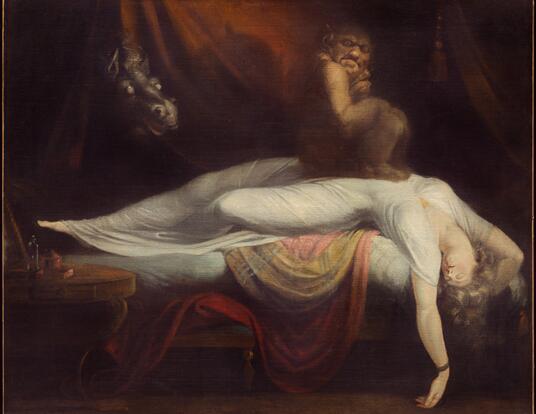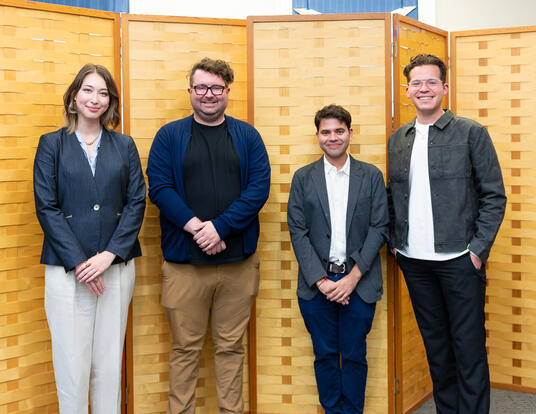Colloquy Podcast: How ‘Hot Vax Summer’ Turned Cold
Starting July 4, 2021, and lasting past the holiday, members of the LGBTQ community converged on Provincetown, Massachusetts, for a vacation that was supposed to mark the end of the long COVID-19 lockdown. When the weather turned rainy, they confidently took the party indoors, packing the little seaside town’s restaurants, bars, and clubs. Why not? They were vaccinated and mask mandates had been lifted.
What happened next shocked both the revelers and the country, shutting down what had been hyped as a “hot vax summer,” and signaling that there was a long way to go before the pandemic was over. In this episode of the Colloquy podcast, PhD student Lydia Krasilnikova—who co-led an 80-person, multi-organization collaboration examining the July 2021 superspreader event in Provincetown—talks about what happened and how the outbreak contributed to the US Center for Disease Control’s decision to resume its recommendation of indoor masking later that year.
(Note: This talk was originally given during the Harvard Horizons Symposium in April 2023.)
Hot vax summer.
We set the stage. It's July 2021. 60% of Massachusetts is vaccinated. Mask mandates are dropping all over the country. Me and my friends are finally going out to our favorite pubs and restaurants unmasked.
Provincetown, Massachusetts is a gorgeous coastal tourist town. It's the weekend after July 4th, and there's a huge multiday party—mostly members of the LGBTQ community, most of them vaccinated.
The weather is gloomy, and the rain pushes everyone inside. Bars, clubs, restaurants all packed. People moving quickly from venue to venue. The stage we've set is perfect.
Less than a week later, the Massachusetts Department of Public Health is alerted to a huge COVID outbreak, the first since vaccination. COVID clearly wasn't over.
I'm part of a group of disease detectives in the Sabeti Lab at the Broad Institute. We work together with hospitals, universities, departments of public health, and other collaborators to trace and learn from outbreaks.
Here's the mystery we solved that summer. The P-town outbreak was 74% vaccinated. It was clear that vaccinated individuals could get infected. But did vaccinated people also spread SARS-COV-2?
Normally, this question would be answered through contact tracing. But contact tracing SARS-COV-2 is extremely difficult. You can get infected from a known contact. But you can also get infected from someone you never saw because SARS-COV-2 is airborne. It can transmit from across a restaurant or club. You can even transmit without being in the same room as a person at the same time. You can stand in a vestibule, leave, and infect someone who stands in that same vestibule 10 minutes later.
So how can you trace an outbreak that spreads through the air, especially in crowded spaces with fast turnover? The answer is that the viruses themselves keep a record of transmission. This record is in their genomes.
Viral spread is a game of telephone. The mistakes the virus makes as it spreads inside your body are passed on to the people you infect. When the virus replicates in their bodies, it makes more mistakes, and the people they infect get both those mistakes and yours and so on, with each generation of infections collecting more and more mistakes. We can use these mistakes to recreate an outbreak after it's happened and learn from it.
We did just that with the P-town outbreak. We worked together with the Department of Public Health to recreate this outbreak from genomic data and then add on vaccination data. First, the Department of Public Health sent us transmission events detected through contact tracing data, including, as you can see, transmission events from in between vaccinated individuals. Then we layered on genomic data, showing plenty more transmission events from and between vaccinated individuals. When the Department of Public Health went back through their contact tracing data, they were able to validate some of these links, confirming that our methods work.
Together, the genomic and the contact tracing data both showed repeated transmission from and between vaccinated individuals. In other words, the answer to our question is, yes, vaccinated people can and do spread SARS-COV-2.
So where does that leave us? Getting vaccinated is still incredibly important. It dramatically reduces your risk of death, severe illness, and long-term effects. But if we want to reduce spread, dramatically reduce spread, especially to vulnerable populations, masking remains one of our biggest, most important tools.
It's also easy to forget that each data point in this figure behind me is a human being. Unfortunately, the P-town outbreak was, in effect, a natural experiment in the LGBTQ-Plus community members and their loved ones. In part, because of this outbreak, the CDC reinstated mask recommendations.
I want to show you one more finding from this project, which is actually my favorite finding from this project. A lot of people wondered if the P-town outbreak seeded the huge Delta wave that followed it. What we found is that actually the opposite happened. Using these methods, we traced the descendants of the P-town outbreak. And we found that even as Delta continued to spread, the P-town outbreak died out. In other words, this outbreak was contained in the middle of a pandemic. You have to admit that is epic.
We believe that this outbreak was contained for two reasons. First, because it was largely vaccinated. And other studies have shown that vaccination decreases the time you spend contagious, which decreases your opportunity to infect other people. Second, because infected individuals work together with contact tracers to identify and warn potential contacts and then protected their loved ones through quarantining and masking.
One thing about fast-spreading diseases like SARS-COV-2 is that they spread exponentially, not linearly. The bright side of this is that the smallest impact you can have on decreasing spread, especially early on, can have a huge impact on the size of the outbreak and on saving lives.
My hope is that what I've shown you today, in terms of what we've been able to learn, is just the tip of the iceberg. We're currently working together with the Massachusetts Department of Public Health to learn from more than 100,000 sequences from positive COVID tests. I'm really, really excited to see what we'll learn. So, stay tuned.
Now, I want to say, as you applaud for me, please also applaud for these 79 coauthors on this study, for everyone who worked on vaccines in this pandemic, and for contact tracers. Thank you so much.
Get the Latest Updates
Join Our Newsletter
Subscribe to Colloquy Podcast
Simplecast





